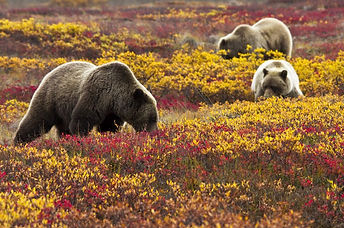M.A.C.AL
The park was named after the soapstone found in the park. But not only does it have beautiful sites to see, it also hold many habitats for the Arctic animals that live there such as the grizzly bear, polar bear, caribou and many more.
The caribou's diet is mainly plants. The caribou mainly eats grass but it has to digs feeding craters to find its food because it is usually covered in snow and is hard to find. But they don't just eat grass, they eat a tip of organism made up by a symbiotic relationship between different organisms. They also eat cranberry shrubs. The caribou is also found in Asia, Greenland, Europe and lastly in Northern parts of north America
Also in Ukkusiksalik National Park there are Grizzly Bears that live there and the grizzly bears cousin the polar bear. They're diet can vary to them eating seeds, berries, roots of plants, different type's of grasses, deer, elk, some fungi, and they're most common source of food fish.
Flora and Fauna


The Brown Bear,more commonly know as the Grizzly Bear, lives in the low south of Nunavut. Although they are seen as big, mean and ferocious, standing at 6-7 feet tall on they're hind legs, they only ever approach humans if they have food, or are to close to there young. They feed on mostly Salmon, but if there strong enough they can bring down Elk, Deer or Moose. They are least concerned on the endangered list.
Grizzly Bear (URSUS ARCTOS)
Caribou are small, deer-like mammals look identical to Reindeer. They are actually the same species, Rangifer tarandus, but there are substantial differences between the two. Caribou are large, wild, elk-like animals which can be found in northern North America and Greenland and have never been domesticated. Reindeer are slightly smaller and were domesticated in northern Eurasia about 2000 years ago. There are still some wild populations of reindeer found in Eurasia but they are best known as a domesticated animal. They are vulnerable on the endangered list.
Caribou (Rangifer tarandus)

The Polar Bear, historically known as a White Bear, is a large bear that lives on the tundra. Because of expected habitat loss caused by climate change, the polar bear is classified as a vulnerable species, and at least three of the nineteen polar bear subpopulations are currently in decline. The Polar Bears consists of Ringed and Bearded Seals, but can also bring down a small Walrus or Beluga Whale. Polar Bears, unlike other bears, don't hibernate during the winter, only pregnant females might. They are vulnerable on the endangered list
POLAR BEAR (Ursus maritimus)
Thanks to Wikipedia, Polar Trec, National Geographic and google images.
